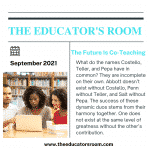Shane Trotter is the author of Setting the Bar: Preparing Our Kids to Thrive in an Era of Distraction, Dependency, and Entitlement. As a writer, social studies teacher, and High-School Strength and Conditioning Coordinator, he has been challenging youth development norms for over a decade. He has been published by websites with millions of readers, such as Quillette, Areo, and Breaking Muscle, and he’s been featured by Spartan.com. His blog, Inspired Human Development, focuses on exploring the principles of human thriving.

What did you learn in school that has really mattered in your life? Was it the periodic table? The parts of the cell? How to multiply polynomials? All of these would be included in a standard high school “core” curriculum, but are they really the core that all students need for success? Perhaps. I don’t mean to diminish math, science, or any traditional academic pursuit. In fact, individuals and society would certainly be better off if most people had a firmer grasp of how the world worked. Still, it seems that by high school much of what we consider “core” is actually niche knowledge, the usefulness of which depends on the individual and their chosen route.
But there are core subjects that are essential to every human. Most fundamentally, everyone needs a basic sense of how to optimize their body and mind. Everyone needs practice developing natural human physical capacities (what is often called physical literacy). And everyone should be well versed in how to create an environment that honors their psychosocial needs. Just as any mechanic needs to know how to keep a car running well, every human needs to know the basics about how humans thrive, regardless of what career path they choose.
This seems obvious, yet these concerns rarely register for school policy-makers. What I’ve seen working in a high school over the past decade is an environment that makes it near impossible for students to be healthy. Students arrive too early—often without having eaten any breakfast. They head to the cafeteria where they can choose between french toast sticks with syrup, funnel cakes (I wish I was making that up), chocolate milk, or Cinnamon Toast Crunch and the other typical cereal brands. To be fair, there is a fruit bowl too, but it doesn’t get a lot of attention. Then they go to their first class. They sit for an hour and then walk to the next class. The cycle repeats as many as 7 times per day with a brief interlude for lunch. Lunch features nachos, pizza, hamburgers, sloppy joes, and all the typical cafeteria fare. Hallways are lined with soda machines, candy machines, and PTA moms selling cookies in the hall. Likewise, every club and extracurricular activity attracts students with cookies or donuts and raises money by selling sweets to teachers and classmates.
After decades of such norms, all of this may seem normal, but it is insane when you consider the costs. Since 1980, obesity has quadrupled for American adolescents between 12 and 19, and a recent Harvard study projects that 57% of today’s kids will be obese by the time they are 35. This is especially concerning given the clear link between obesity and many debilitating and deadly conditions such as diabetes and heart disease. No institution is better suited to combat these trends than the education system. Schools control the collective habits and daily environment of an entire generation, but they currently do more to encourage poor health than to correct it. In nearly every moment of our children’s educational careers, the school environment funnels them toward unhealthy patterns—the collective toll of which is comparable to handing them all cigarettes.
It would be easy to misconstrue my critique as a puritanical desire to purge the world of sweets, but no one who has tried my cinnamon rolls would make that mistake. On the contrary, I love a good dessert from time to time. My issue is with the paradigm we are handing our kids that tells them it is normal to subsist predominantly on treats and industrial foods. We should be giving our children a template for how to take care of themselves and to have a good relationship with food—where they enjoy healthy foods and can have an occasional treat without feeling compelled to indulge every day. By contrast, the norms we’ve given them virtually guarantee their futures will be riddled with health struggles and that, lacking any model of healthy living, future attempts to improve their habits will be confusing and frustrating. Because of the warped environment, we put them in, most students today look at healthy eating like it is a bizarre, cultish lifestyle choice. Consequently, they are unlikely to entertain its merits until precarious health forces them to do so. We’ve set our children up for failure.
It is not only foolish to facilitate such debilitating habits, it also conflicts with the explicit goals that most schools orient themselves around. If you want the mind to operate at its peak, you need to take care of the body. This is obvious to anyone who has felt the brain fog accompanying jet lag or who has found themselves short of temper after a sleepless night. It is more obvious still to any elementary school teacher who has had the misfortune of trying to teach math to a class of students who have not had recess in three hours.
Today, it is common for American elementary schools to eliminate recesses and limit P.E. to two 30-minute blocks each week. We make policies as if students are computers who will hold more knowledge if only we give them more time to download the necessary information. From this perspective, the best way to achieve higher test scores is simply to spend more time on class instruction. Physical activity is seen as a quaint luxury of a simpler time and a simpler people. It is an inconvenience standing in the way of precious instructional time. But removing blocks of physical activity, unstructured free time, and sunlight in order to make more time for classroom teaching is a bit like removing lunch so that students can get 30 more minutes of math practice. It reveals a school’s fundamental lack of understanding about how humans work best.
Not every school or every country is so shortsighted. As most educators know, Finland is a model of educational excellence around the globe, routinely ranking at the top of international tests of math, science, and reading. But this was not always the case. Over the course of a decade they went from one of the worst education systems in the developed world to one of the best. In order to explore how they achieved this transformation, Dr. Debbie Rhea of TCU went to Finland to see their schools firsthand. She came away convinced that the most obvious and actionable difference was recess. Elementary-age kids in Finland are given fifteen minutes of recess for every 45 minutes of classroom instruction. Additionally, they teach structured physical movements every day. This is founded in Finland’s more balanced educational philosophy. As Rhea explains, “They do not see art, music, and physical education as electives or specials, but instead see them as important as other content such as language arts, math, history, science, geography, foreign language, and so on.”
Rhea’s experience in Finland inspired her to create the LiiNK Project, which has convinced many elementary schools to begin implementing four recesses each day. Teachers at these schools rave about the improvements in student focus and behavior. One kindergarten teacher at Eagle Mountain Elementary in Fort Worth, Texas described the changes she’s seen: “They were always antsy, messing with the name tags on their desks, poking each other, rolling around on the floor.” However, since implementing the four recesses “They’re able to get all that energy out. Coming in, they’ll just be sitting on the carpet zoned in and engaged for 45 minutes.” Inconvenient or not, kids need to move. The students’ restlessness was their body’s way of signaling a need. As the late educational reformer, Sir Ken Robinson said in one of his TED Talks:
“If you sit kids down, hour after hour, doing low-grade clerical work, don’t be surprised if they start to fidget. Children are not, for the most part, suffering from psychological problem. They are suffering from childhood.”
Our minds don’t operate as well when we are sleep-deprived, sunlight deficient, or loaded up on sugar and processed foods. This has as much to do with being a human as it does being a kid. Over the summer, I would often spend entire days trying to write or work on creative projects in preparation for my book release. However, over and over I found that I could only produce quality work for a couple of hours before I needed a break. I learned that I needed to make time for physical and social breaks and to dedicate afternoons to email and other task work. By building my schedule around my nature, I got much more done.
Humans are not machines who will learn and produce in a linear fashion relative to the time they spend working on a project. Likewise, we are not run strictly by logic. We can resolve to eat healthier, study more, or exercise (as nearly every adult will, repeatedly and unsuccessfully, attempt to do in their lives), but we are likely to fail in these habits if we don’t understand the mechanisms behind the behavior. We are humans with complex needs rooted in our long nomadic past. In the ancestral environment—the one our biology is evolved for—we acquired all of our food from our immediate environment, spent nearly all of our time outdoors, and lived in deep connection to our tribe. Days were spent active and engaged in purposeful activities with people we cared about. Everyone got plenty of Vitamin D from the sun and no one struggled to wind down after hours staring at a screen.
By contrast, today there are more temptations pulling at our attention, implanting new cravings, and exploiting our impulses than ever before. Previously impossible foods tantalize us, mass convenience removes any reason for us to exert ourselves, and we are constantly drawn to the magnetic appeal of infinite entertainment. As Brandon Hidaka said in a 2012 article for The Journal of Affective Disorders, “In effect, humans have dragged a body with a long hominid history into an overfed, malnourished, sedentary, sunlight-deficient, sleep-deprived, competitive, inequitable, and socially-isolating environment with dire consequences.”
Yet, despite the dire state of public health and the abundance of research on how to optimize human health, happiness, and performance, our school system largely ignores the topic. We’ve devalued health and physical education so much that most teachers feel comfortable openly mocking these subjects. They are relegated to the corners of the building—unseen, unheard, and inconsequential in the eyes of most educators (sometimes even those who teach them).
As we move deeper into the age of automation, it will be more foolhardy than ever to neglect these concerns in favor of a “career-preparation” approach. We have no idea what the jobs of the future look like. Even high-earning careers like radiology are subject to massive disruption. All we know is that technology will continue to change the landscape and force us to adapt. In such a world, we can’t predict which specific skills will be most valuable for any student. They will still need a baseline level of competency in math, science, social studies, and language. But the most important tools we can help students develop are a capacity to overcome adversity, to be capable of learning well and subjecting arguments to critical analysis, and, most of all, to know how to adapt to their environment and their behavior so they can thrive—to master themselves.
Schools almost entirely neglect this last piece without realizing that it hurts their other stated goals. There are a number of obvious policy shifts that schools could make if they wanted to prioritize human flourishing and optimize student performance:
- Start Time: Start high-school at 9 am at the earliest. According to the National Sleep Foundation, children between six and 13 need nine to 11 hours of sleep per night, while teens ages 14-17 need eight to 10 hours. Getting enough sleep is correlated with better health, behavior, grades, emotional stability, and energy. We know it matters and we know that adolescents (whose parents are less likely to enforce a bedtime) will tend to go to bed at the same time no matter when school starts. They will get more sleep if we delay start times. Who knows? Maybe they will even take the time to eat a good breakfast.
- Control the Nutritional Environment: Eliminate chips, soda, candy, cookies, and all sweets and heavily processed foods from the school building. There is some obvious grey area. Serving thousands of meals each day will demand that cafeterias utilize frozen and canned foods. Still, the majority of what is available on a school campus should be minimally processed foods closely approximating their natural form. As for snacks, it’s time we had vending machines that only had options like cashews, almonds, peanuts, and perhaps Triscuits or comparable cracker alternatives.
- Standing Desks: We know that standing is healthier (both ergonomically and cardiovascularly) than sitting and that standing desks promote far more engagement and activity. Equip every classroom with adjustable standing desks that come with a high stool.
- Recess: Have recess four times per day in elementary school, as suggested by Dr. Debbie Rhea’s LiiNK program.
- Longer Passing Periods: Like elementary students, high school students also need intermittent bouts of sunlight, social activity, and freedom. Offer longer (10 minutes at least) passing periods for high school students between classes and push students to get outside in these time periods. It will be well worth whatever time is cut from other structured activities.
- Take P.E. Seriously: Bring back the classical model of P.E. Like the classical model of education, classical P.E. sought to give students ownership of their development by teaching fundamental human principles. In addition to games, the classical approach asked students to master fundamental gymnastic skills, restorative arts, and martial arts. Perhaps nothing would improve the quality of our culture and empower our children more than to make this a daily course that was a respected part of the core curriculum.
- Train the Mind as a Core Subject: Change the high school core curriculum to include habit and self-mastery courses. Ideally, these would emphasize psychology and time management, and would also offer daily blocks of mindfulness training of about 5-15 minutes. There are a lot of connotations around meditation and mindfulness, but its benefits are too overwhelming to ignore. As psychologist Jonathan Haidt explains in his book, The Happiness Hypothesis:
“Suppose you read about a pill that you could take once a day to reduce anxiety and increase your contentment. Would you take it? Suppose further that the pill has a great variety of side effects, all of them good: increased self-esteem, empathy, and trust; it even improves memory. Suppose, finally, that the pill is all-natural and costs nothing. Now would you take it? The pill exists. It is meditation.”
Sounds like schools would be insane not to implement such a tried and true method for personal enhancement.
- Work to Change Parental Norms: People tend to take on the prevailing norms of their environment. Schools have immense power to help shape these norms by identifying threats to human flourishing and educating families on how to chart a better course. Schools should begin offering monthly or weekly parent education where they help parents understand the current environmental pitfalls, address troubling trends that work against student flourishing, and promote common sense solutions. For example, the smartphone is ravaging the minds of young people today. It inhibits sleep, social relationships, focus, posture, and the proclivity to explore. But it is hard for parents to hold off on getting their students a smartphone when all of their friends have one by age 10. Schools could create the expectation that parents should not give their students a smartphone until high school and help parents understand how to use apps like Bark and Screentime to limit the pernicious effects once their student has a smartphone.
In my forthcoming book Setting the Bar, I devote a few chapters to outlining what an education system should look like to promote the greatest possible human flourishing. I argue that subjects like physics and calculus are electives that are only essential to those who will need them, but that there is a more relevant core curriculum that all students need. This includes:
- The Foundations of a Healthy Lifestyle
- Humanity and Self-Mastery
- Rhetoric and Human Relationships
- Cognitive Bias and the Skill of Learning
- Political Theory, Citizenship, and 20th-Century World History
- Essential Financial Strategies
I clearly outline the specifics of each of these in the book. To be clear, I am anything but anti-academic. Learning history and practicing written argument and Socratic inquiry is also essential for collective human flourishing. But any system that claims to teach core principles must focus on physical education, health, and behavior management—what I call “self-mastery.” These are fundamental tools that all of our students need to thrive in the 21st century. If we want to give our kids the best opportunity to transcend the pitfalls of our time, we will need to stop ignoring what is most core to all.






